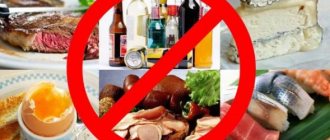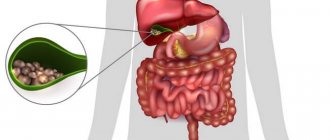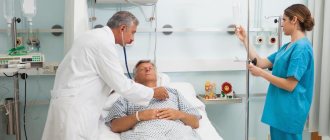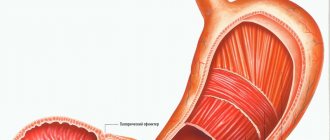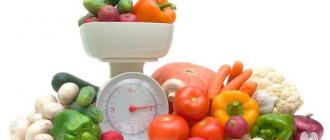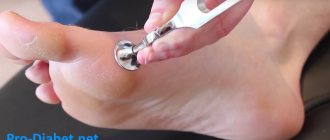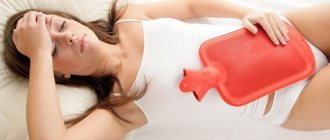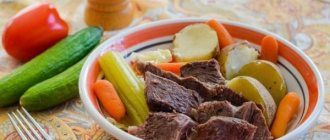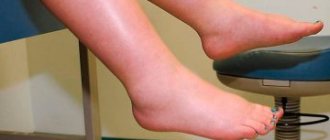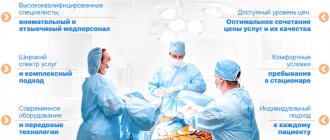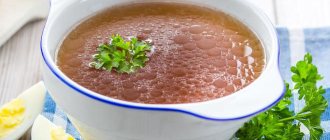When the gallbladder becomes inflamed, specialists diagnose cholecystitis. It usually appears due to eating disorders, overeating, and constipation. In this case, it is necessary to adhere to dietary nutrition, which is as important as drug therapy. The gallbladder and liver are important for the functioning of the digestive system, as they are responsible for the breakdown of fats, the absorption of vitamins and nutrients, and cleansing the body of toxins and waste. With the participation of bile, enzymes and substances in the blood plasma function normally. Doctors prescribe a diet to reduce the food load on the gastrointestinal tract.
Oatmeal for exacerbation of cholecystitis
General rules
Diet for gallbladder disease is an essential component of treatment for both acute and chronic forms of cholecystitis , cholangitis (inflammation of the bile ducts), and biliary dyskinesia . The basic diet for these diseases is Table No. 5 and its varieties.
In case of acute cholecystitis, in order to maximize sparing of the gastrointestinal tract in the first days, complete fasting is indicated. Only warm drinks in small portions are allowed: weak sweet tea, berry and fruit juices diluted with water, rosehip infusions. On days 3-4, an anti-inflammatory version of diet No. 5 is prescribed - Diet 5B .
Light food in pureed form without broth and butter is introduced into the diet in limited quantities: slimy soups (oatmeal, rice, semolina), liquid pureed oatmeal and rice porridges with a small addition of low-fat milk, pureed compotes, jellies, vegetable juices. Then include in small quantities well-mashed steamed meat, low-fat cottage cheese, boiled fish, wheat bread or crackers.
Meals are fractional, in small portions (at least 5 times), without sodium chloride , with plenty of liquid (up to 2.5 l/day). The calorie content of the daily diet is 1600 kcal (50-60 g protein, 40-45 g fat, 200-250 g carbohydrates). On days 8-10 the patient is transferred to Diet 5A and then to Diet No. 5 .
In case of chronic cholecystitis (without exacerbation), the main principles of dietary nutrition are maximum sparing of the gallbladder and liver with physiologically adequate nutrition, normalization of bile secretion and cholesterol in the blood, and in the absence of diarrhea , strengthening of intestinal function ( Diet No. 5 ).
Small and frequent meals are provided to promote the outflow of bile. To enhance bile secretion, salads and vinaigrettes seasoned with unrefined vegetable oils are introduced into the diet. The diet includes various vegetables, berries and fruits that stimulate the process of bile secretion, and the high fiber content eliminates constipation .
All easily digestible carbohydrates (jam, sugar, sweets, honey) are excluded or sharply limited from the diet, since their consumption leads to stagnation of bile, as well as vegetables containing oxalic acid (sorrel, spinach) and essential oils in large quantities (citrus fruits). The diet includes chicken eggs (not more than one), but it must be remembered that yolks enhance the motor function of the gallbladder and have a choleretic effect.
For pain or bitterness in the mouth caused by eating eggs, only egg whites are included in the diet. The calorie content of the daily diet is at the level of 2700-2900 kcal (proteins -100 g, including animals - 60%, fats -90 g, including vegetable 30%, carbohydrates -450 g).
Salt consumption is limited (10 g), liquid at the level of 1.5-2 liters. With a sharp exacerbation of chronic cholecystitis, the diet is similar to the diet for acute cholecystitis .
For combined diseases of the pancreas and gall bladder ( pancreatitis + cholecystitis ), Table No. 5P . This table is characterized by an increase in the content of proteins and vitamins and a restriction in the diet of fatty and carbohydrate foods.
Products containing a lot of extractives and purine bases (cabbage broth, meat and fish broths), refractory fats of animal origin, and sugar are excluded from the diet. Avoid hot, spicy, sour, sweet and fatty foods that stimulate the function of the pancreas, as well as foods rich in fiber. Food is cooked mainly by steaming, meals are divided into small portions. The total caloric content of the diet is reduced to 2500 Kcal.
Occurrence of stones
Almost 70% of gallstones are based on cholesterol. The second group of stones has a mixed composition with cholesterol and calcium salts. Only 7% of stones have a pure calcium base. The formation of cholesterol stones is not associated with internal disorders. It depends on the person's poor diet. Excess of this substance comes only with specific foods.
It is almost impossible to get rid of gallstones without the help of medications. Find out if there are medications to treat gallstones.
Varieties
The varieties of Diet No. 5 include, in addition to those described above, also a lipotropic-fat diet - 5 l/f. Prescribed to patients with cholecystitis for problems caused by stagnation of bile. cholesterol from it .
The diet increased the fat content (50% of which is vegetable oils), slightly increased the protein content (up to 100 g) and reduced the amount of carbohydrates (300 g) by limiting sugar. Total calorie content is 2600 kcal.
The diet provides for a sharp limitation in the consumption of extractive substances (meat and fish broths), cholesterol and foods containing large amounts of essential oils. The diet is enriched with lipotropic protein products (egg whites, cottage cheese, lean meat, fish), refined vegetable oils, wheat bran, vegetables and fruits.
All types of oils (butter and vegetable) are added only to ready-made dishes. Refractory animal fats, butter dough, spices, and whole milk are excluded. Food is prepared by baking or boiling; chopping is not necessary.
- Diet No. 5B - acute cholecystitis , during a period of sharp exacerbation of chronic cholecystitis.
- Diet No. 5A - on days 8 - 10 of treatment.
- Diet No. 5 - in the recovery stage, after Diet 5A.
- Diet 5 l/f - cholecystitis , accompanied by stagnation of bile.
- Diet No. 5P - for a combination of cholecystitis and pancreatitis .
General principles of treatment of cholecystitis
When an inflammatory process is initially detected, conservative therapy is followed: antispasmodics, antibiotics are prescribed, and detoxification therapy is carried out. If drug treatment is ineffective or there is a risk of complications, surgery (laparoscopic cholecystotomy) is prescribed.
A therapeutic diet for acute cholecystitis relieves the gallbladder and reduces signs of the inflammatory process. It is recommended to fast during the first day. After 2 days, it is allowed to include pureed dishes in the diet during exacerbation of cholecystitis with a limit of carbohydrates to 200 g per day and protein to 80 g. Foods can only be prepared without salt. The main principle of the diet for ordinary and calculous cholecystitis during an exacerbation is split meals and eating food in small portions. At the same time, it is recommended to consume at least 2.5 liters of liquid per day.
Authorized Products
Permitted products and dishes include vegetable and cereal soups with vegetable broth, beetroot soup, vegetarian cabbage soup, milk soups with pasta, fruit soups, dried wheat bread, dry biscuits, savory pastries with fish, boiled meat or cottage cheese, and apples. Meat - chicken fillet, lean young lamb, beef, rabbit, milk sausages. Low-fat white fish and seafood.
The diet should contain dairy products: kefir, fermented baked milk, yogurt, whole low-fat milk, low-fat cottage cheese and dishes based on it (casseroles, puddings, lazy dumplings), mild, low-fat cheese. Chicken eggs in the form of an omelet and soft-boiled eggs are allowed. Cereals (especially oatmeal and buckwheat), boiled pasta.
The diet should contain vegetables both raw and in various forms of cooking (stewed and boiled), non-acidic sauerkraut, green pea puree, vegetable salads with vegetable oil, vinaigrette, squash caviar, and greens. As snacks, the diet includes low-fat herring, diet, doctor's sausage, stuffed fish, lean ham, boiled fish and meat.
Sweet products include various non-acidic fruits and berries, dried fruits, marmalade, jam, honey, marshmallows. It is recommended to combine sugar with xylitol ( Sorbitol ). All fats (butter and vegetable oil) are introduced into the dish in their natural form. Recommended drinks: black/green tea, vegetable, fruit and berry juices, decoction of wheat bran and rose hips, still mineral water.
Basic nutrition rules
The diet during exacerbation of chronic cholecystitis is extremely gentle. During this period, the inflamed gallbladder is not able to fully participate in digestion. Therefore, in case of painful symptoms, solid food is excluded, and the diet consists only of drinks. In the first days, it is important to drink a lot, both pure water (not carbonated) and juices, decoctions, compotes, tea. Compotes from sweet berries and fruits and juices that are not too concentrated are allowed (you can dilute them with water). A good remedy during this period will be rosehip decoction. Lightly brewed tea with sugar is also indicated.
On about the third day, the diet for cholecystitis during an exacerbation is allowed to be slightly varied. Add pureed cereal soups, liquid porridge (especially oatmeal), cottage cheese, and white bread croutons. You can include some fish in your diet so that your weakened body gets more energy. All this should be eaten warm. Such food will ensure the functioning of the gallbladder in a gentle manner.
The diet menu for chronic cholecystitis after a period of exacerbation is more varied. But there are certain rules that must be followed:
- Fractional meals. You need to eat 5-6 times a day at approximately equal intervals, in small portions. It is best to eat at the same time.
- Warm food. Too hot or cold dishes can disrupt the functioning of the gallbladder, leading to spasm and exacerbation of the disease.
- Proper preparation. You will have to forget about fried foods, giving preference to stewed, baked and boiled. Moreover, during processing you will have to abandon any oil.
These nutritional principles will help normalize the functioning of the gallbladder. Bile will be produced in the right amount, and painful symptoms will subside.
General principles
For diseases of the gastrointestinal tract, it is recommended to adhere to diet No. 5 . It was developed within the framework of a systematic approach to the disease and has its own characteristics:
- You should not overeat, smoke or drink alcoholic beverages.
- It is preferable to prepare dishes from pureed ingredients. This reduces the degree of irritation of internal organs.
- Salt consumption is limited.
- To enhance the choleretic effect and quickly absorb vitamins, it is better to consume vegetables with sunflower oil.
- Fats in minimal doses - 50 g per day must be present in the diet to stimulate bile production and prevent stagnation.
- Animal protein should not dominate the diet.
- The optimal food temperature is from +20 to +59 degrees.
- The recommended frequency of meals is 6 times a day with equal intervals and portions, so as not to overload weakened organs.
- You need to adhere to the drinking regime - drink at least 3 liters of clean water per day.
Nutrition for chronic cholecystitis
A patient with chronic inflammation of the organ will be forced to eat in accordance with diet No. 5 for the rest of his life. It is especially important to adhere to the following rules:
- Meals should be fractional (about 6 times a day), portions should be small.
- You need to drink at least 2 liters of fluid per day. In addition to water, you can drink herbal tea, compote, jelly, filtered water, etc.
- Salt intake should be minimal.
- Food and drinks must be warm.
Chronic cholecystitis is a dangerous disease, so foods that contribute to the occurrence of liver colic and spasms should be completely excluded from the diet. If you do not follow the rules of nutrition, gallstone disease may develop.
For chronic cholecystitis, it is necessary to include in the daily menu:
- lean meats and fish, boiled or steamed;
- milk sausage and premium sausages;
- buckwheat, rice, vegetable, fish soups or borscht without frying;
- durum pasta;
- boiled potatoes;
- crackers and bran bread (stale or yesterday);
- biscuits;
- fresh fruits and vegetables;
- egg white omelette and soft-boiled eggs (1 piece/day;
- herbal and green teas, freshly squeezed juices, fruit drinks, compotes;
- mineral water with sulfates.
As soon as the symptoms of chronic cholecystitis disappear or weaken, it will be possible to add sugar (no more than 8 teaspoons) and table salt (no more than 9 g) to the patient’s daily diet.
Diet for gallbladder diseases
Proper nutrition is the key to the normal functioning of the gastrointestinal tract (GIT), including the gallbladder. The healing table helps reduce the load on the digestive tract. A properly selected diet helps reduce bile production, eliminate dyspeptic disorders and reduce unpleasant symptoms of gallbladder diseases.
For mild disorders and dysfunctions, sometimes it is enough to adjust the diet to normalize the condition. Properly selected nutrition allows you to permanently consolidate the achieved remission in chronic gallbladder diseases and prevent relapse. An important factor is the initial symptoms, which need to be responded to immediately.
Patients begin to experience pain in the right side and an attack of nausea. As the disease progresses, other symptoms appear: heartburn, vomiting, lack of appetite, weight loss. Experts say that if you start treatment in a timely manner, then in ninety percent of cases you can avoid further development of the process. Diet is no less important than medications. Without it, the entire treatment process may not bring any results.
The development of gallbladder pathologies is largely the fault of the person himself, because the main reason for the development of dysfunction is improper and unbalanced nutrition. The intense rhythm of modern man forms the habit of snacking on the go and dry food, eating fast food, and taking long breaks between meals. In this article we will talk in detail about what the gallbladder loves, and also find out which foods are best avoided if you have existing diseases.
A little about the disease
Cholecystitis is an inflammatory process of the gallbladder, which often occurs with the formation of calculi (stones). The disease can be acute or chronic. In 80% of patients, examination reveals gallstones, and in 40-60% of patients, bacterial contamination of bile (cocci, E. coli). In the presence of stones in the gall bladder and stagnation of bile, an inflammatory process develops, which often contributes to the development of complications - purulent inflammation, perforation of the mucous membrane, cholangitis.
!It is extremely important to seek help during the progression of the acute form of the disease, because during this period it is possible to eliminate the inflammation with medication and avoid recurrence of the pathology in the future.
Main symptoms of cholecystitis:
- pain in the right hypochondrium, which often spreads to the upper abdomen, can radiate to the back (biliary colic);
- slight increase in temperature;
- weakness, decreased performance;
- nausea, vomiting with bile;
- decreased appetite.
With purulent forms of cholecystitis, there is a high probability of perforation of the organ wall, the development of gangrene and death. When contacting a gastroenterologist, therapist or hepatologist, specialists will offer to undergo cholecystography, laboratory tests, duodenal intubation, and ultrasound of the abdominal organs.
General principles
The gallbladder plays a vital role in the process of digesting food. Bile enters this organ from the liver, which is then released into the duodenum. The secretion helps digest fats and move them through the intestines. Normally, the gallbladder can produce up to two liters of bile. Dysfunctions of the biliary system entail pathological changes in other organs, including the pancreas. That is why quite often, along with cholecystitis, patients are diagnosed with pancreatitis.
Of course, the main treatment for gall bladder problems involves the use of medications. But therapeutic therapy will be more successful and effective if you follow the correct diet. You shouldn’t give yourself any slack and lose your temper by starting to consume prohibited foods. It is extremely important to follow all recommendations, otherwise exacerbations and severe pain may occur.
A diet for gallbladder disease involves following the following recommendations:
- fractional meals in small portions;
- compliance with therapeutic nutrition until stable remission is achieved;
- restriction in the diet of animal fats and legumes;
- a balanced diet, including a sufficient amount of vitamins and microelements;
- avoid overeating;
- exclusion of alcohol, coffee, cocoa.
When the pathology worsens, it is better to consume food in liquid form. These can be pureed vegetable soups in lean broth, juices, tea without sugar. After surgery, a vegetarian diet is prescribed. Sufficient fluid intake plays an important role in treatment. For the entire period of treatment you will have to give up sauces, spices, marinades, salted, fried, smoked foods.
It is also important to consider the cooking method and temperature of the food consumed. It is necessary to avoid fried foods. It is preferable to steam, bake, stew, or boil food. The gallbladder does not like cold or too hot food; it should be comfortably warm.
Dish recipes
Vegetable puree soup. To prepare the soup, you need to take zucchini, eggplant, carrots, onions, sweet peppers (2 pcs.), potatoes (5 pcs.), 2 tbsp. l. olive oil, herbs. First you need to prepare the pepper: you need to put it in boiling water, and then in cold water and remove the skin. Cut vegetables into cubes. Boil 3 liters of liquid, put potatoes in a saucepan and add a little salt to the water.
After 10–15 minutes, you need to add all the remaining ingredients, except for the zucchini (they are added 5 minutes before the end of cooking). The resulting mass must be cooled, grind in a blender and add herbs and olive oil.
Stuffed pepper. In order to make this dish, you need to take 6 bell peppers, 0.5 kg of chicken fillet, 3 tbsp. l. boiled rice, carrots and onions (2 pieces each), a glass of tomato juice, 2 cloves of garlic, paprika and bay leaf. Peppers need to be peeled and pierced with a fork. Then you need to mix boiled rice, minced chicken, chopped garlic, and paprika. Chop the onions and carrots, simmer in a frying pan until soft and add tomato juice. You need to stuff the peppers with the prepared minced meat, place it on a baking sheet and bake in the oven for 30–40 minutes.
Baked apples. To prepare you will need 4 large apples, 1 egg, 100 g of cottage cheese, 2 tbsp. l. sugar and cinnamon. You need to cut out the middle of the apples. Beat the yolk with cinnamon and sugar, mix this mass with cottage cheese in a blender. Then you need to pour a little water onto a baking sheet, put the stuffed apples and bake at 180 ° C for 15 minutes.
Squid soup. Ingredients: 100 g cabbage, cucumbers (250 g), squid, greens, 800 ml vegetable broth and salt. The squid needs to be cleaned and cut into small strips. Boil the broth and add cabbage to it, and then cook for 6 minutes. Add squid, chopped cucumbers to the soup, add salt and cook for 4 minutes. The finished soup should be sprinkled with chopped herbs.
Fish souffle. You need to take 30 ml of milk, 90 g of fish, an egg, salt and a piece of butter. First you need to boil the fish fillet, grind it in a meat grinder or blender, add the yolk, milk, salt and butter to the minced meat, mix all the ingredients thoroughly. The white must be beaten and added to the rest of the products. Place minced meat in a frying pan and bake at 180°C. It is permissible to bake the soufflé in special molds and steam it.
Permitted and prohibited products
A diet for gallbladder disease is prescribed by a doctor individually for each patient. Typically, experts recommend adhering to the principles of treatment table No. 5. When answering the question of what you can eat, nutritionists highlight a list of recommended foods:
- vegetable and milk soups, as well as with the addition of cereals. Do not use thick oil frying in cooking. Doctors recommend preparing soup from sour or fresh cabbage, chicken noodle soup or borscht with beets and sour cream;
- lean meat and fish;
- chicken eggs in small quantities (no more than two per day). They can be drunk raw, hard-boiled or steamed;
- dairy products;
- cereals;
- vegetable oil;
- rosehip decoction, compote, jelly;
- vegetables, fruits, berries;
- butter in limited quantities;
- Among sweets, honey, marmalade, preserves, jam, and marshmallows are allowed.
For baked goods, dried bread, biscuits or crackers are allowed. Vegetables and fruits can be consumed both fresh and boiled.
Now let's highlight the most valuable products for the gallbladder:
- apples. They contain a large amount of iron and pectin, which help improve the quality of bile secretion;
- carrots and pumpkin are famous for their high content of carotene, which is transformed into vitamin A. This substance normalizes the functioning of the gallbladder and other gastrointestinal organs;
- beets and cabbage take an active part in the production of bile;
- rosehip is a source of ascorbic acid, necessary for the normal functioning of the organ;
- seaweed contains iodine, which supports the functioning of the digestive tract;
- dried apricots and dates contain potassium, which improves the contractile properties of the tissues of the digestive organ.
Diet for gallbladder disease also implies some restrictions. Patients should not eat the following foods during an exacerbation:
- pancakes, potato pancakes, pancakes;
- sausages, smoked sausages;
- baking;
- strong meat or mushroom broths;
- confectionery;
- nuts;
- lentils, peas, beans;
- chocolate, ice cream, cream;
- carbonated drinks;
- animal fats;
- onion, garlic, radish, horseradish.
Let's consider a sample diet menu for existing problems with the gallbladder:
- breakfast. Buckwheat or oatmeal porridge in water with dried bread and a small piece of butter. A glass of green tea with milk;
- lunch. Kefir with oven-baked apple;
- dinner. Puree vegetable soup with lean broth. Mashed potatoes with oven-baked fish and vegetables. Dried fruits compote;
- afternoon tea Broccoli and zucchini casserole. Dried bun with compote;
- dinner. Boiled chicken breast with cucumber and tomato salad. A glass of low-fat kefir and biscuits.
Dietary nutrition for disorders of the biliary system helps normalize body weight, improve bowel regularity, eliminate heartburn and abdominal pain, and also prevent relapse.
Cholelithiasis
Gallstone disease (GSD) varies from patient to patient, but is always characterized by viscous bile with an altered chemical composition, as well as an intensive process of stone formation. In addition to treatment with medications, physical therapy and surgery, experts recommend constantly following a diet, which can not only alleviate the condition, but also prevent relapse. There are several stages of the disease, in which nutrition differs.
Read also:
What should be the diet for cholecystitis of the gallbladder?
Chemical stage of cholelithiasis
At this stage, there is a failure in the production of bile by the liver and its release from the gallbladder. The substance increases concentration, accumulates in the gall bladder, becomes viscous and contains many bile acids, cholesterol and phospholipids. If the disease is detected at this stage and there is no treatment, the process of formation of suspensions, flakes, and bile sediment may begin. Without symptoms, this continues for a long time, moving to the second, latent stage.
Latent stage of cholelithiasis
During the latent stage of the disease, bile stagnates and active stone formation begins. This usually occurs with inflammatory foci on the mucous membranes of the bile organ, thickening of its walls. During instrumental diagnostics, doctors detect “silent” stones. The stage can last for decades without manifestation of stone activity, there are no symptoms, and the patient is unaware of the disease.
Clinical stage of cholelithiasis
The most dangerous stage of gallstone disease is when the stones begin to move through the ducts. This process is accompanied by pain in the right part of the peritoneum in the hypochondrium, and biliary colic may occur. Each patient has an individual course of pathology - from sluggish to acute with frequent relapses. It is important to consider the size of the stones and their location.
How to eat during an exacerbation of cholelithiasis?
In case of exacerbation of cholelithiasis, it is necessary to use dietary table No. 5A. They adhere to its rules for a couple of weeks until the condition stabilizes, after which they switch to diet No. 5. An approximate menu for a day could be as follows:
- breakfast of semolina porridge or steamed protein omelet, tea with the addition of low-fat milk;
- snack - buckwheat with olive oil, steamed meat cutlets, stale white bread, weak tea;
- lunch - vegetarian soup with rice and vegetables, steamed chicken fillet, buckwheat with unrefined butter, dessert in the form of milk jelly;
- dinner - boiled fish and mashed potatoes, tea with low-fat milk;
- Before going to bed, you can drink a glass of kefir.
During an exacerbation, strict adherence to dietary rules may prevent surgery and eliminate or stop the process of stone formation by normalizing the viscosity of bile and its chemical composition.
YouTube responded with an error: Daily Limit Exceeded. The quota will be reset at midnight Pacific Time (PT). You may monitor your quota usage and adjust limits in the API Console: https://console.developers.google.com/apis/api/youtube.googleapis.com/quotas?project=726317716695
Nutrition for various gallbladder diseases
What diseases of the biliary system are common nowadays? The leading position is occupied by dyskinesia.
Dyskinesia
The development of pathology is based on a violation of the outflow of bile. According to statistics, the disease more often manifests itself in women of reproductive age with an asthenic physique. The disease manifests itself in the form of pain in the right hypochondrium, which is of a dull bursting nature. Patients often complain of bitterness in the mouth, belching, and nausea.
Biliary dyskinesia can develop against the background of chronic stress, a sedentary lifestyle, allergic reactions, and dietary errors. Therapeutic nutrition is prescribed to reduce the aggressive effects of internal and external environmental factors on affected organs. The diet also includes providing the body with healthy foods that contain vitamins and minerals necessary for recovery.
Patients with dyskinesia should eat five to six times a day. Overeating is prohibited, as it puts additional stress on the gastrointestinal tract. Frequent meals in small portions help eliminate accumulations of bile secretions and improve digestion processes. If possible, eat your meals at the same time every day. Diet is no less important than choosing healthy foods.
Overeating as one of the causes of cholecystitis and gall bladder problems
The rhythm of life of a modern person does not always allow him to eat 5-6 times a day in small portions and consume natural products prepared at home. Most often, people snack on fast food and chips at work, and wash down this unhealthy food with sweet carbonated drinks, which, apart from additional calories, do not bring any benefit.
Overeating gradually becomes a habit. Its scale is growing along with the material well-being of people and the variety of food products. Unfortunately, the quality of food is noticeably deteriorating, causing overeating from a harmless habit to turn into a real medical problem.
But even in conditions of intense busyness, you can organize your diet in such a way as to avoid overeating, which leads not only to obesity, but also significantly reduces the quality of life. Due to the constant overcrowding of the stomach, its walls are overstretched, and the entire digestive system is subject to additional stress, which can provoke the appearance of symptoms of gastrointestinal diseases: cholecystitis, pancreatitis, gastritis, peptic ulcer, duodenitis.
People who overeat experience discomfort:
- nausea;
- stomach ache;
- vomit;
- bowel disorders;
- flatulence;
- decreased performance and activity;
- sleep problems;
- apathy.
The body, which is forced to constantly digest food and spend enormous resources on it, quickly wears out. He has no energy left for important internal processes that constantly occur with a person, including ensuring the activity of the immune system. Tissue poisoning occurs with unprocessed decay and metabolic products. Ultimately, overeating leads to decreased physical and mental potential and directly interferes with personal growth.
If you've already overeaten, help your digestion. To digest food, you need to take medications containing digestive enzymes. They are directly involved in the breakdown of foods and accelerate their absorption. Drugs of this type include Pancreatin, Mezim, Creon.
The habit of constantly chewing something does not allow the stomach to rest even for several hours and overloads the liver and gall bladder. Train yourself to chew your food thoroughly. The signal of satiety reaches the brain 15 minutes after the start of the meal. If you eat in a hurry, during this period of time you will have time to overeat and completely fill your stomach. Reduce the amount of salt you consume, use less pepper, and season foods with spices that greatly increase your appetite.
How to follow a diet during an exacerbation of the gallbladder?
When the gallbladder becomes inflamed, specialists diagnose cholecystitis. It usually appears due to eating disorders, overeating, and constipation. In this case, it is necessary to adhere to dietary nutrition, which is as important as drug therapy. The gallbladder and liver are important for the functioning of the digestive system, as they are responsible for the breakdown of fats, the absorption of vitamins and nutrients, and cleansing the body of toxins and waste. With the participation of bile, enzymes and substances in the blood plasma function normally. Doctors prescribe a diet to reduce the food load on the gastrointestinal tract.
Oatmeal for exacerbation of cholecystitis
Nutrition for acute cholecystitis
In acute inflammation of the gallbladder, a strict diet is required.
- In the first few days, to relieve the burden on digestion, the patient is allowed to drink only compotes of sweet fruits and berries, having previously diluted them with boiled water in a 1:1 ratio. Warm teas, which include chamomile, mint, lemon balm, and rosehip, effectively eliminate the symptoms of the disease.
- As soon as the patient’s health improves, he can be given pureed porridge and vegetable broths. Portions should be minimal, each dish should be washed down with plenty of liquid. Experts recommend using skim milk to prepare porridges and soups. The best options would be rice porridge, oatmeal and semolina. The menu should also be diversified with cauliflower, broccoli, mousse, fruit or berry jelly. You are allowed to drink still mineral water diluted with warm boiled water.
- If you strictly follow the diet rules, the patient’s condition will improve after 2 weeks. The diet can be expanded, but we must not forget about the restrictions. Any smoked meats, fatty, hot and spicy dishes will remain prohibited. Soups will need to be ground before consumption, and beans, baked goods, chocolate products, mushrooms, pearl barley and millet will have to be completely abandoned.
Cholecystitis
Cholecystitis is characterized by inflammation in the cavity of the liver and gallbladder, which occurs due to infectious damage to the mucous membranes of the organ. The cause may be stagnation of bile and its altered chemical composition. Experts note two types of the disease: acalculous or calculous with the formation of stones. The inflammatory process can be catarrhal or with the release of pus.
Cholecystitis is characterized by the following symptoms:
- pain under the ribs on the right and in the gall bladder area. Typically, increased pain occurs after consuming fatty foods, alcohol, carbonated drinks, or during strong emotional experiences. Signs appear in the form of dull pain, sharp piercing pain with impact in the neck and shoulder, shoulder blade;
- manifestations of dyspepsia and reflux of bile into the intestinal tract, a bitter taste appears in the mouth in the morning, there may be vomiting and constant nausea;
- from the intestinal side, symptoms manifest themselves in the form of frequent constipation and diarrhea, intolerance to dairy products, and bloating.
Eliminating the symptoms of inflammation in the gallbladder with a therapeutic diet is the most important component of the treatment of cholecystitis. Dietary nutrition helps improve the patient's condition with cholangitis, dyskinesia, and inflammatory processes in the biliary system.
Features of diet 5 during remission and exacerbation
For cholecystitis, biliary dyskinesia, hepatosis, a diet for the liver and gallbladder is prescribed - table No. 5. If you have pain in the gallbladder, heaviness in the liver, or nausea after eating fatty foods, you must adjust your diet.
Table No. 5 involves reducing the calorie intake, giving up animal fats and simple carbohydrates. You need to consume plant foods that normalize the flow of bile.
The diet for different diseases is different:
- In acute cases, it is necessary to relieve the digestive organs as much as possible. Table No. 5a will help with this. First, the patient must fast for 2-3 days. Next, you need to avoid solid foods to reduce inflammation. It is also better to exclude salt from the diet. You need to drink 2 liters of filtered water per day. It is also allowed to drink weak unsweetened tea, vegetable broth, jelly, decoctions of dried fruits, rose hips (without sugar). After a few days, you can move on to pureed soups and cereals. When the condition improves, diet No. 5 is prescribed.
- In the chronic form, the diet becomes more varied. The main thing is to eat low-fat foods, give up sweets, and reduce the dose of sugar. Confectionery products are replaced with fruits. It is recommended to eat organic foods and follow a regular diet.
If the functionality of the gall bladder is impaired, it is prohibited to drink alcohol-containing drinks.
Diet for cholecystitis: what can you eat?
Unfortunately, the therapeutic diet includes very few products and dishes. But if you try, you can create a varied menu from this list. Here is a list of what is allowed for cholecystitis:
- Soups. These can be regular soups and purees made from vegetables, cereals, meat and fish. Meat broth should not be concentrated, so it will have to be prepared from low-fat varieties (veal, chicken, turkey).
- Porridge. It is better to cook them in water or milk diluted with water in a 1:1 ratio. Buckwheat, rice and oatmeal are recommended.
- Meat and fish of low-fat varieties. You can stew, boil, bake separately or with vegetables. Use salt to a minimum, and avoid other spices altogether.
- Vegetable oil. Use it only in salads. Cooking with oil is not recommended, as it releases harmful carcinogens when frying.
- Dairy products. In moderate quantities (up to 0.5 liters per day) you can eat fermented baked milk, kefir, yogurt, and yogurt. Cottage cheese (up to 200 g per day) is also useful.
- Vegetables, berries and fruits. You can eat them in their natural form, but it is better to heat them. Vegetables - bake, stew, from fruits - cook compotes and juices.
- Pasta. Can be eaten as a side dish without using hot sauces or gravies.
- Bread. Bakery products with bran are highly recommended as they help improve digestion. Crackers are also healthier than freshly baked bread, which causes fermentation in the stomach.
Diet dishes for gallbladder cholecystitis can be varied by combining products. For example, it is advisable to add different fruits to your breakfast porridge. This way it will become not only healthy, but also tasty. Cottage cheese can be eaten in its pure form, but it is better to make casseroles with different vegetables (pumpkin, carrots) or dried fruits (raisins, dried apricots). By trying new dishes, you won't feel like your diet is too limited.
What is allowed?
It is important to eat more fresh fruits and vegetables, as they have a mild choleretic effect and improve intestinal motility.
Dry cookies are a good option for breakfast or a small snack during the day. It will help you quickly satisfy your hunger and will not harm your health. It is also not forbidden to drink a raw egg, but this is not for everyone.
Inflammation of the gallbladder is not such a death sentence for the patient, since there are a number of foods that can still be eaten. These include:
- low-fat dairy products: milk powder, cheeses, cottage cheese;
- porridge, beans, pasta;
- soups with milk or fruit broth. Vegetable soups also go well;
- you can also eat vegetable oil and even butter, but only in very small quantities;
- the meat should be lean. The best food to eat for inflammation of the gallbladder is chicken or beef. Fish is not prohibited, but also low-fat varieties. It is better to steam or boil it;
- You can eat any greens; canned green peas and cabbage are also allowed;
- jam and honey, sugar can be consumed for this disease.
Vegetable fats, that is, olive, soybean, sunflower oil, must be used in the diet for inflammation in the gallbladder. They contain phospholipids, polyunsaturated fatty acids, vitamin E, which help dilute bile. Also, it is vegetable oils that enhance the contraction of the muscle fibers of the gallbladder.
What products are not allowed?
If the patient is in remission, this does not mean that the disease has disappeared without a trace. The diet must be designed taking into account the fact that certain foods can trigger an exacerbation. Instead, the diet is enriched with those that have an anti-inflammatory effect and have increased nutritional value.
| Name | What not to eat |
| Beverages | Coffee, sparkling water, alcohol, stevia and its extract, whey, hibiscus, concentrated juice |
| Liquid dishes | Cooked with fatty meat, mushroom broth, fish soup, green borscht, okroshka |
| Porridge | Peas, lentils. |
| Meat | Offal, sausages, smoked meats, stewed meat, pork, lamb fat. |
| Fish and seafood | Canned fish in oil and tomato, salmon, trout, smoked herring, caviar of all types, sushi, crab meat |
| Bread | Puff pies and cookies, muffins, pancakes |
| Fermented milk products | Salted cheese, full-fat milk, cream |
| Vegetables | raw cabbage, greens, vegetables with essential oils that irritate internal organs - radishes, garlic, onions |
| Fruits | Figs, citrus fruits, persimmons, nuts |
| Eggs | Fried |
| Fats | Unrefined sunflower oil, lard, margarine |
| Snacks | Ginger in marinade, olives |
| Gas stations | Mayonnaise, sauces, seasonings |
| Sweets | Chocolate, confectionery with cream, sesame candies, kozinaki, fresh biscuits |
If you ignore the recommendations of doctors and continue to consume prohibited foods, this is fraught with complications, including the need for surgical intervention.
More about cholecystitis
The main cause of cholecystitis (inflammation of the gallbladder) is a disturbance in the bile outflow system.
Cholecystitis can have either an acute form, developing over several days, or a chronic form, bothering a person throughout his life.
The symptoms of acute cholecystitis are similar to those of many abdominal disorders, so diagnosis of this disease should only be carried out by a qualified doctor.
If you feel severe discomfort in the abdominal area that lasts more than a few hours, do not hesitate and consult a doctor immediately.
He will conduct an examination, identify the causes of poor health and prescribe adequate treatment for the problem.
Symptoms of acute cholecystitis:
- severe hyperthermia (from 38 degrees Celsius and above);
- chills (with severe intoxication of the body - fever);
- severe cutting pain felt in the right ilium (can radiate to the chest);
- constant nausea and vomiting that does not bring relief.
With severe intoxication of the body, patients suffering from cholecystitis may experience jaundice of the skin and sclera of the eyes, as well as severe allergies.
Treatment of acute cholecystitis is carried out in a hospital setting. A person who has acute inflammation of the biliary tract must be constantly under the supervision of doctors and receive the necessary drug treatment on an hourly basis.
If therapy with specialized drugs does not bring relief to the patient, then he is referred for drainage of the abdominal cavity or a full-fledged abdominal surgery is initiated to neutralize the causes and consequences of cholecystitis.
Chronic cholecystitis has similar, but different in intensity symptoms:
- muted pain that regularly occurs in the right ilium, radiating to the lumbar spine and, mainly, manifesting itself after eating;
- frequent nausea;
- colic in the liver;
- mild form of jaundice (increased if the correct menu is not followed).
Is it possible to cure chronic cholecystitis? Unfortunately no.
However, you can significantly mitigate the symptoms of cholecystitis by using comprehensive treatment and adhering to the rules of a specially designed menu that excludes the consumption of all potentially hazardous foods.
What is prohibited to eat
Confectionery products and sweets are prohibited if you have inflammation of the gallbladder.
As you can see, the number of permitted products for inflammatory processes in the gallbladder is quite large, but do not forget that today, along with healthy foods, there are also a large number of additives that are dangerous for one or another pathology. It is necessary to clarify with a specialist what is prohibited and what cannot be eaten in case of pathologies.
The list of such products includes a large number of dishes. Thus, products prohibited for pathologies of gastrointestinal tract are: fatty foods - sausage, smoked foods; some types of meat - pork, lamb, goose, duck. It is necessary to limit the intake of vegetable oil and foods containing easily digestible carbohydrates - fresh baked goods, confectionery and candies. The consumption of products such as buns and hamburgers contributes to the disruption of the mucous membrane and aggravates the disease process and symptoms. In addition, the list of products prohibited for diseases of the gastrointestinal tract includes alcoholic beverages, semi-finished products, canned food and marinades.
Limiting these foods is useful not only in case of identified pathologies, but also in a relatively healthy body, since they are often the cause of diseases of the digestive system.
How to eat for pregnant women with cholecystitis
Patients with cholecystitis during pregnancy must strictly follow a diet, since the body itself will not be able to cope with the pathology in this situation. It is the consumption of certain foods that in most cases provokes attacks of cholecystitis in this position. Pregnant women should not eat fatty meat and fish, or consume fermented milk products. Also, during pregnancy and a tendency to exacerbation of cholecystitis, it is important to exclude baked goods, chocolate, nuts, coffee, soda, smoked foods, salty foods, marinades and spicy foods from the diet.
The most important factor during pregnancy is eating food at the right temperature. Pregnant women should not eat anything too hot or cold; the temperature of the food should be in the range of 30-50 degrees. Also, pregnant women need to eat small meals so as not to increase pressure and create additional stress on the organs of the gastrointestinal tract.
Therapeutic fasting
Short-term abstinence from food can have different effects depending on the existing disease, as well as the individual characteristics of the patient. Therapeutic fasting is widely practiced for acute pancreatitis.
This procedure allows you to stop the production of pancreatic enzymes, which corrode and destroy organ tissue. In addition, refusing food cleanses the organ after the inflammatory process and helps accelerate regeneration processes.
Now let's talk about the features of fasting with cholecystitis. As you know, the procedure is of two types: dry and wet, that is, with the use of liquid. The first type of fasting is usually prescribed for a chronic process. When cholelithiasis develops, it is absolutely forbidden to refuse food and liquid!
Fasting during cholecystitis will help stop the acute inflammatory process
Fasting is an effective method of treatment, but it can also be harmful if the patient does not know the rules for its implementation. It is also important to understand how to properly overcome hunger. Having entered the mode of refusing food, it is extremely necessary for the patient to remain in bed. Usually, with acute cholecystitis, a person is not more bothered by the feeling of hunger, since the pathological process is accompanied by nausea and even vomiting.
Important! Prolonged fasting is fraught with the fact that toxic substances will activate a new wave of the inflammatory process.
Do not forget about contraindications to the procedure, these include:
- anemia;
- hypoglycemia, in which the level of glucose in the blood decreases;
- arterial hypotension;
- avitaminosis.
The need to follow a diet
Following a diet for cholecystitis is the basic principle of treating the disease.
The treatment table not only alleviates all the unpleasant signs of inflammation of the gallbladder, but also normalizes the functioning of the gastrointestinal tract as a whole, eliminating problems with the stomach (gastritis) and intestines (constipation, diarrhea).
Proper nutrition for cholecystitis helps to lose excess weight, which plays an important role in the causes of the disease, activates the growth of beneficial microflora in the intestines, strengthens the immune system, and, most importantly, prevents the development of complications.
Menu for the week
To create daily menu recipes, it is necessary to take into account the characteristics of the disease and the final goals:
- In general, the amount of food per day should not exceed 3 kg.
- Fruits and vegetables from the permitted list are used as a snack.
- Dishes can be baked, boiled and steamed.
- Before cooking, remove all veins, fat, tendons from the meat, remove the skin from the chicken.
- Food that is hot or too cold can cause another attack.
Recommended menu for patients with attacks of cholecystitis for a week:
| Breakfast | Lunch | Dinner | Afternoon snack | Dinner |
| Liquid oatmeal soup, rosehip infusion | Fresh banana, 100 grams of lean cottage cheese | Vegetable broth with any permitted cereal, pepper with lean meat, compote | Shredded vegetables, rye bread croutons | Noodle soup with milk, 3 pcs. biscuits |
| Curd pudding or casserole, a handful of raisins, coffee drink, milk | Sliced fruit with apples, pears, 1 tsp. honey, a handful of nuts | Liquid buckwheat porridge, steam cutlets, berry or fruit jelly | 2 oven-baked apples, compote | Vinaigrette, 1 egg omelette, |
| Lazy dumplings 200g, rosehip infusion | 2 pcs. canapes with zucchini caviar | Soup from fish and other seafood, greens, 1 boiled chicken leg, jelly | Sliced fresh apples and carrots, 1 tbsp. honey | Macaroni with cheese and dill, tea |
| Liquid semolina porridge, black tea with milk | 1 slice of grain stale bread, 1 egg omelette, greens | Mashed potatoes, steamed fish, 1 tomato | Tea | Fruit salad, rosehip decoction |
| Millet with low-fat sausage, tea, milk | Baked pumpkin, rosehip decoction | Stewed or steamed cabbage, boiled meat, a slice of rye flour bread | 100 g cheese, compote | Sauteed vegetables, stale grain bread |
| Milk soup with noodles, drying, weak tea | Vegetable casserole, rosehip infusion | Lenten seafood soup, lean boiled beef, jelly | 50 grams of cheese, 1 piece tomato, greens | Lean fish, boiled or stuffed with steamed vegetables, infusion of rose hips |
| Puff pastry pies with chicken, poultry or rabbit, tea with milk | 100 g dried fruits, jelly | Liquid pilaf with boiled lean meat, salad of fresh tomatoes and cucumbers | 1 piece of yesterday's bread, unsweetened curd mass, herbs, tea | Pumpkin puree with 1/2 cup milk |
Based on personal preferences, the wishes of the patient and individual characteristics, culinary recipes for the dietary menu can be adjusted by adding or replacing goods and dishes with products from the list of permitted and recommended ones.
Nutrition rules after cholecystitis
After the symptoms of the disease disappear, it is recommended to engage in physical therapy, drink mineral water, and perform gallbladder tubing (rinsing the bile ducts). To prevent bile stagnation, the patient should walk in the fresh air every day and follow a diet. The doctor will advise you in more detail about the rules of nutrition, taking into account the patient’s condition and the individual characteristics of his body.
After recovery, the patient must follow a strict diet for several months.
If surgery was performed due to the disease, then during the recovery of the body the patient must follow diet No. 5. In the first months, it is recommended to eat pureed foods (boiled or steamed). After some time, it is expected that the diet will be expanded to include animal proteins, seasonal fruits, and vegetables.
Recommended Products
Following a diet for acute and chronic cholecystitis should become part of life for a long time. This will help avoid recurrence of the pathological condition. The assistant is a list of products allowed for consumption:
- fruits (sweet apples, melon, bananas, etc.);
- eggs (preferably quail);
- low-fat fermented milk products and milk;
- chicory;
- oil (preferably olive);
- lean meat products;
- lean types of fish;
- cauliflower;
- fresh vegetables, with the exception of cabbage;
- rosehip decoction, jelly, compote, weak tea;
- cereals (buckwheat, oatmeal, semolina, rice);
- pumpkin and sunflower seeds;
- mousse, marshmallow.

